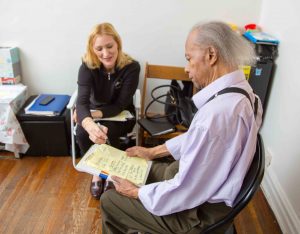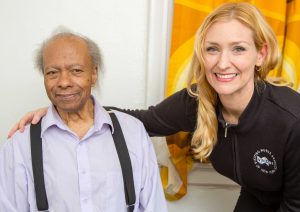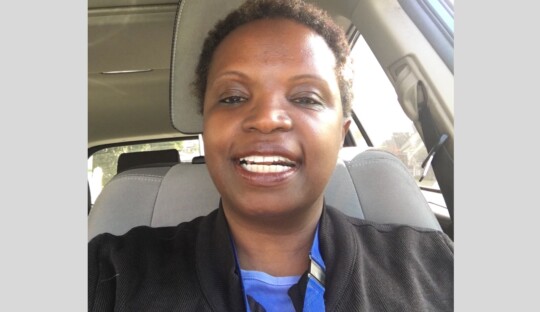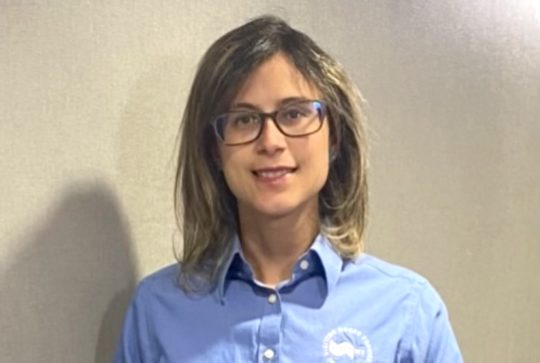From Successful Fashion Designer to VNSNY Social Worker: Meet Lizzie Cogan
 How VNSNY Social Worker Lizzie Cogan uses her design background to help patients.
How VNSNY Social Worker Lizzie Cogan uses her design background to help patients.
Originally from Macon, Georgia, Elizabeth “Lizzie” Cogan, a social worker in VNSNY Home Care’s Brooklyn region, dreamed of moving to New York City and becoming a fashion designer. She accomplished that goal, graduating from Parsons School of Design in 1996 with a degree in fashion design and establishing a successful line of high-end women’s coats. But while her coats were featured in Elle magazine and sold in a Fifth Avenue department store, another career path called to her.
“My husband, Daniel Cogan, was working as a nurse practitioner in VNSNY Hospice and Palliative Care,” Lizzie recalls. “I heard Daniel and his colleagues asking their patients essential questions like, ‘What do you need?’ Their job was to make their patients’ lives as good as possible by meeting those needs. It seemed to me that their work was a real privilege—perhaps less glamorous than my work as a designer, but much more gratifying.”
So, Lizzie began to pursue a new career in social work. She volunteered at Covenant House, an organization that serves homeless youth, and interned as a counselor at MercyFirst, a program for children and families, and at Edward R. Murrow High School in Brooklyn. Meanwhile, she pursued a Master of Social Work degree at Fordham University. After graduating, she joined VNSNY in 2012, working in the VNSNY CHOICE Enrollment Unit where she helped people apply for health insurance. “It was a wonderful introduction to the complexities of Medicaid,” she says.
 In 2013, Lizzie transferred to VNSNY Home Care, where she has continued to apply and refine her social work skills. “We assist patients who have major illnesses, usually upon release from the hospital, and help them safely transition back to life at home and in the community,” she explains. Following an initial assessment, Lizzie’s interventions might include connecting her patient with a senior center, making referrals to support organizations such as CancerCare, and helping her patients understand and make full use of their Medicaid benefits. One patient, for example, was spending a fortune on Uber, unaware of the transportation coverage available to him under Medicaid until Lizzie informed him about it.
In 2013, Lizzie transferred to VNSNY Home Care, where she has continued to apply and refine her social work skills. “We assist patients who have major illnesses, usually upon release from the hospital, and help them safely transition back to life at home and in the community,” she explains. Following an initial assessment, Lizzie’s interventions might include connecting her patient with a senior center, making referrals to support organizations such as CancerCare, and helping her patients understand and make full use of their Medicaid benefits. One patient, for example, was spending a fortune on Uber, unaware of the transportation coverage available to him under Medicaid until Lizzie informed him about it.
She also educates patients about their eligibility for short-term disability coverage and the importance of long-term care planning—including choosing a health care proxy and assisting with advance care planning. While social work in the field is a long way from the design studio, there are occasions when Lizzie needs to be just as creative. Last December, for example, one of her patients, Beatrice*, suffering from dementia, was in need of a new family caregiver after her previous caregiver moved away. Searching for a potential replacement, Lizzie contacted the patient’s daughter, who was living in Barbados caring for her mentally disabled adult son. Over the phone, Lizzie explained Beatrice’s condition and needs, and outlined the local availability of dementia care as well as mental health services for the daughter’s son. Within two weeks, the family was reunited in Brooklyn, and three lives were improved.
Lizzie is grateful for the support she receives from her managers, particularly Jeri Goodman, Social Work Manager for VNSNY Home Care. “Jeri is an excellent manager—very accessible and informative,” she says. “I really appreciate the guidance my managers have given me, as well as their trust and confidence that I can go in and perform my role.” With their support, she’s gone on to earn Supervisor in Field Instruction certification at the NYU Silver School of Social Work, as well as her Certified Case Manager credential.
While other organizations may perform services similar to VNSNY’s, adds Lizzie, “What makes us special is our compassion and commitment to the most vulnerable members of society.” While Lizzie’s relationships with home care patients tend to be of limited duration—she’ll typically make one or two home visits, supported by follow-up phone calls—that’s one of the things she loves about her work. “In a one-hour visit you can identify and meet a lot of needs,” she notes. “What drives me is a curiosity to understand people’s circumstances; to hear their stories, empathize with them, and work out how to improve their situation. I’m grateful that I have the potential to walk in the patient’s door, and later to leave with the feeling that I’ve had an impact on that person’s well-being.”
 In addition to the practical guidance Lizzie offers to her patients, she also works to address their emotional needs. To Lizzie, this integrative process is not unlike her work as a designer. “Sometimes I think of the visit like a painting,” she says. “The logistical work is like a pencil sketch that lays down the structure. But I always try to address the patient’s emotional needs through empathy and reflective listening, as well. That adds the color to the painting. For example, I might explore with a patient the question, ‘What keeps you strong?’ Within that question, I might learn about the importance that patient places on his or her faith community. This tells me that arranging transport for a patient’s medical visits can also help him or her get to church, which helps fulfill essential emotional, social and spiritual needs. In this work, everything is connected.”
In addition to the practical guidance Lizzie offers to her patients, she also works to address their emotional needs. To Lizzie, this integrative process is not unlike her work as a designer. “Sometimes I think of the visit like a painting,” she says. “The logistical work is like a pencil sketch that lays down the structure. But I always try to address the patient’s emotional needs through empathy and reflective listening, as well. That adds the color to the painting. For example, I might explore with a patient the question, ‘What keeps you strong?’ Within that question, I might learn about the importance that patient places on his or her faith community. This tells me that arranging transport for a patient’s medical visits can also help him or her get to church, which helps fulfill essential emotional, social and spiritual needs. In this work, everything is connected.”
* The patient’s name has been changed for privacy.


